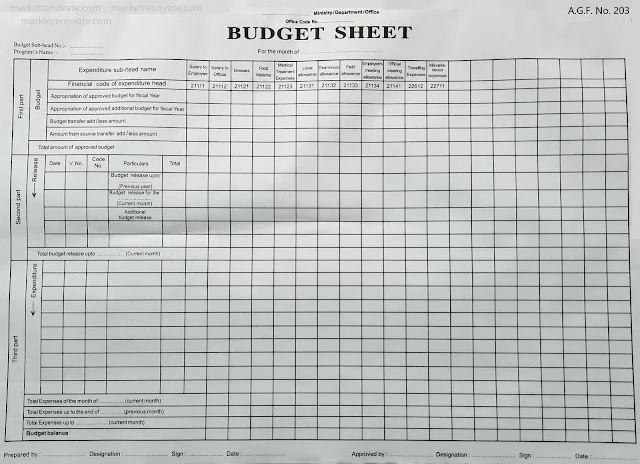Budget Sheet and its Components
A “budget sheet,” often referred to as a “budget worksheet” or “budget template,” is a financial tool used to plan, track, and manage personal or organizational finances. It provides a structured format for organizing income, expenses, and financial goals. A budget sheet is a basic financial management instrument used in government agencies, particularly in Nepal. It is a thorough declaration that is essential for controlling and monitoring financial activity within the restrictions of the given budget. While the Budget Sheet is divided into three major sections, it is critical to grasp its overall purpose and relevance apart from these sections.
A Budget Sheet, at its heart, serves as a financial compass and management device. It is intended to provide an accurate and complete account of how financial resources are allocated, released, and spent within a government office or department within a given fiscal year. This document is critical for maintaining fiscal responsibility, transparency, and adherence to budgetary constraints and financial requirements.
A Budget Sheet’s primary function is to record and display the annual budget appropriations. These allocations represent the maximum amount of money that can be spent during the fiscal year in various budget categories or heads. Government offices have a clear awareness of their financial bounds since these appropriations are documented, which helps avoid overspending and ensures that financial resources are spent wisely.
The Budget Sheet also details the monthly release of monies from central-level offices. It tracks the initial and subsequent money releases, allowing for a real-time view of the financial influx. This data is critical for government offices to efficiently manage their resources and allocate funding to various initiatives, projects, and operational expenses as needed.
The Budget Sheet also functions as a repository for budget expenses. It meticulously details all expenses incurred under various budget categories and subcategories. This includes both routine spending and cash advances. Government offices can analyze their financial health, monitor spending patterns, and make educated judgments about resource allocation and cost control by keeping track of these expenses.
Furthermore, the Budget Sheet promotes financial openness and responsibility. It enables regular monitoring of budget limitations and financial requirements. The information contained in the Budget Sheet can be utilized by government financial authorities to make smart financial decisions, ensuring that funds are handled responsibly and efficiently.
In conclusion, a Budget Sheet is an essential instrument in the financial administration of Nepalese government departments. It is a comprehensive financial statement that aids in the control of expenditures, the monitoring of budgetary constraints, and the maintenance of transparency and responsibility in financial activities. The Budget Sheet’s basic aim, despite its various components, is to promote wise financial management and ensure the appropriate use of public monies within the context of government financial systems.
Components/ Parts of a Budget Sheet
Here are the key components and their meanings within a budget sheet:
- Annual Appropriation Section:
- Meaning: This is the first part of the Budget Sheet and represents the initial allocation of the annual budget. It details the financial plan for the fiscal year, specifying the budget appropriations assigned to different budget heads and sub-heads. These allocations serve as the maximum permissible limits for expenditures in each category.
- Significance: The Annual Appropriation Section sets the financial boundaries within which a government office must operate during the fiscal year. It is essential for maintaining fiscal discipline, as exceeding these limits requires approval from higher authorities. This section also records inter-head and inter-office transfers of budget, allowing for a clear overview of how funds move within the budgetary framework.
- Budget Release Section:
- Meaning: The second part of the Budget Sheet, the Budget Release Section, comes into play as funds are released to government offices. It meticulously tracks the monthly releases of budgetary funds, including initial and additional imprest fund releases. These funds flow into the government office in installments.
- Significance: This section provides real-time visibility into the financial inflow, allowing government offices to manage their resources effectively. It ensures that funds are available when needed for various programs, projects, and operational expenses. At the end of the fiscal year, this section is closed by depositing any surplus funds into the Freeze Account or Consolidated Fund Account, contributing to financial accountability.
- Budget Expenditure Section:
- Meaning: The Budget Expenditure Section, the third and final component of the Budget Sheet, is where all budget expenditures are meticulously recorded. It encompasses expenses incurred under different budget heads and sub-heads, ranging from regular expenditures to advance transactions. It also includes expenditures made through petty cash funds.
- Significance: This section is at the heart of financial accountability and control. It tracks how funds are utilized throughout the fiscal year. Expenditures are recorded in accordance with budget head numbers provided in the columns, with brackets often used to distinguish between advance clearances and actual expenditures. Regular monitoring of this section allows government offices to assess their financial health, identify spending patterns, and make informed decisions about resource allocation and cost control.
You Might Like These Posts:
Sample Budget Sheet
Here’s a simplified sample of Budget Sheet for illustrative purposes:
Public Health Theme: “Maternal and Child Health Promotion”
Budget Sheet (in Nepalese Rupees – NPR):
| Budget Head and Sub-head | Annual Budget Allocation (NPR) | Monthly Budget Allocation (NPR) |
|---|---|---|
| Personnel Costs | ||
| – Health Workers | 1,200,000 | 100,000 |
| – Administrative Staff | 500,000 | 41,667 |
| Program Expenses | ||
| – Health Education Materials | 300,000 | 25,000 |
| – Vaccination Campaigns | 800,000 | 66,667 |
| – Antenatal Clinics | 1,000,000 | 83,333 |
| Infrastructure | ||
| – Clinic Renovations | 500,000 | 41,667 |
| – Equipment Purchase | 700,000 | 58,333 |
| Community Outreach | ||
| – Training Programs | 400,000 | 33,333 |
| – Community Health Workers | 600,000 | 50,000 |
| Monitoring and Evaluation | 200,000 | 16,667 |
| Contingency Fund | 100,000 | 8,333 |
| Total Annual Budget | 5,900,000 | – |
Notes:
- This is a simplified example/sample of budget sheet for illustrative purposes. In practice, a more detailed budget sheet would be needed, with specific line items and justification for each expense. Below is the original budget sheet format of Nepalese Government Accounting System.
- The budget is broken down into various categories such as personnel costs, program expenses, infrastructure, community outreach, monitoring and evaluation, and contingency funds.
- Monthly allocations are calculated based on the annual budget. For example, if the annual budget for health workers is NPR 1,200,000, the monthly allocation is NPR 100,000 (NPR 1,200,000 / 12 months).
- The “Total Annual Budget” summarizes the overall budget allocation for the selected public health theme.
Budget Sheet of Nepal Format







Please leave your comments or ask your queries here. The comments shall be published only after the Admin approval.